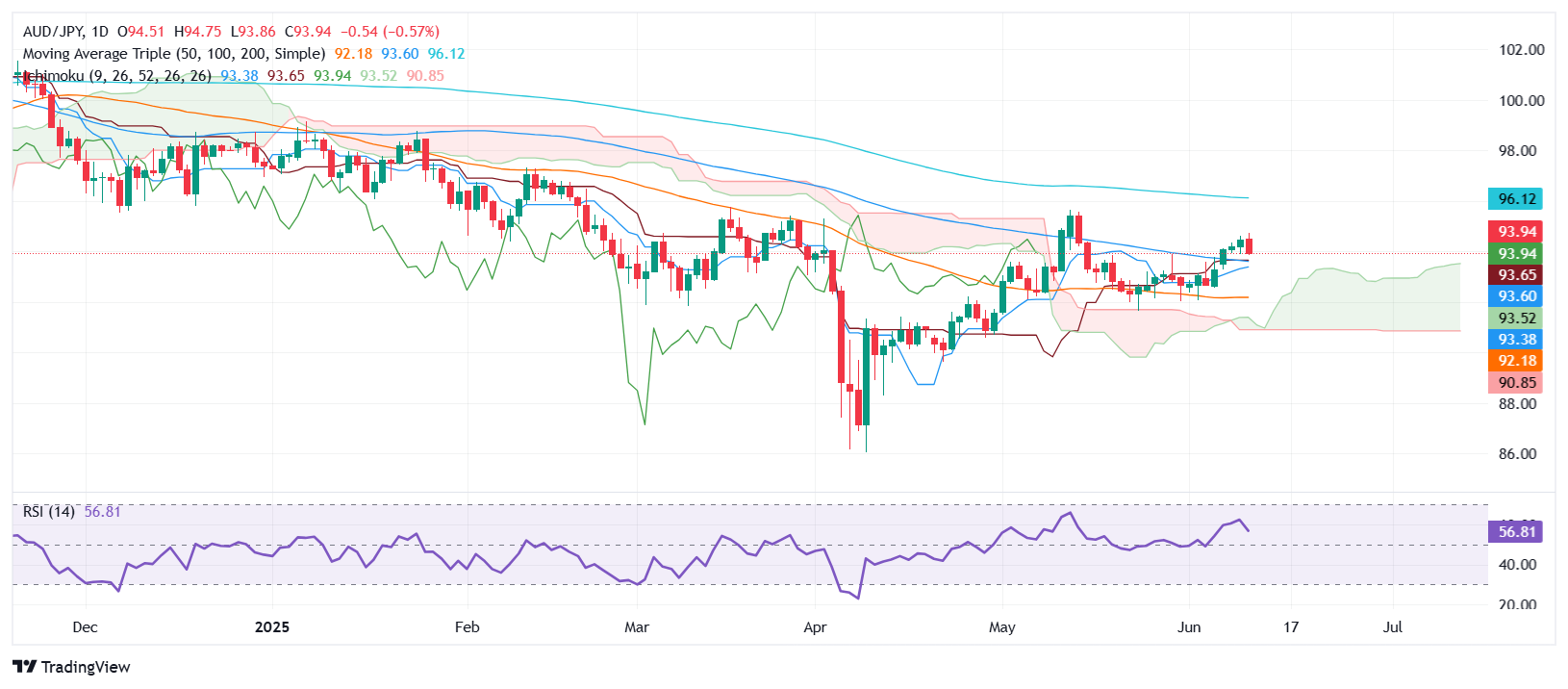AUD/JPY Price Forecast: Hits monthly high, retreats below 94.00 as bearish signal emerges
- AUD/JPY drops over 0.56% after peaking at 94.73, failing to sustain gains.
- Bearish engulfing pattern suggests downside pressure building.
- Key support levels: 93.51 (Senkou Span A), 93.39 (Tenkan-sen), and 93.00.
The AUD/JPY failed to clear the 94.00 resistance level and dropped by over 0.56% on Wednesday, following a monthly high of 94.73, after an upbeat risk mood and a weaker-than-expected US inflation report. At the time of writing, the pair traded near 93.90, virtually unchanged.
AUD/JPY Price Forecast: Technical outlook
The cross-pair formed a ‘bearish engulfing’ candle chart pattern, suggesting that the AUD/JPY is set to test lower prices. Nevertheless, the Relative Strength Index (RSI) remains bullish, but if the RSI slides below its neutral line, the pair could test the June 3 low of 92.04.
If AUD/JPY tumbles below the Senkou Span A at 93.51, up next lies the Tenkan-sen at 93.39, ahead of the 93.00 figure.
Conversely, if buyers reclaim 94.00, the first resistance would be 95.00. The next key supply zone would be the May 13 daily high at 95.63 before testing at 96.00, and the February 12 high of 97.32.
AUD/JPY Price Chart – Daily

Australian Dollar FAQs
One of the most significant factors for the Australian Dollar (AUD) is the level of interest rates set by the Reserve Bank of Australia (RBA). Because Australia is a resource-rich country another key driver is the price of its biggest export, Iron Ore. The health of the Chinese economy, its largest trading partner, is a factor, as well as inflation in Australia, its growth rate and Trade Balance. Market sentiment – whether investors are taking on more risky assets (risk-on) or seeking safe-havens (risk-off) – is also a factor, with risk-on positive for AUD.
The Reserve Bank of Australia (RBA) influences the Australian Dollar (AUD) by setting the level of interest rates that Australian banks can lend to each other. This influences the level of interest rates in the economy as a whole. The main goal of the RBA is to maintain a stable inflation rate of 2-3% by adjusting interest rates up or down. Relatively high interest rates compared to other major central banks support the AUD, and the opposite for relatively low. The RBA can also use quantitative easing and tightening to influence credit conditions, with the former AUD-negative and the latter AUD-positive.
China is Australia’s largest trading partner so the health of the Chinese economy is a major influence on the value of the Australian Dollar (AUD). When the Chinese economy is doing well it purchases more raw materials, goods and services from Australia, lifting demand for the AUD, and pushing up its value. The opposite is the case when the Chinese economy is not growing as fast as expected. Positive or negative surprises in Chinese growth data, therefore, often have a direct impact on the Australian Dollar and its pairs.
Iron Ore is Australia’s largest export, accounting for $118 billion a year according to data from 2021, with China as its primary destination. The price of Iron Ore, therefore, can be a driver of the Australian Dollar. Generally, if the price of Iron Ore rises, AUD also goes up, as aggregate demand for the currency increases. The opposite is the case if the price of Iron Ore falls. Higher Iron Ore prices also tend to result in a greater likelihood of a positive Trade Balance for Australia, which is also positive of the AUD.
The Trade Balance, which is the difference between what a country earns from its exports versus what it pays for its imports, is another factor that can influence the value of the Australian Dollar. If Australia produces highly sought after exports, then its currency will gain in value purely from the surplus demand created from foreign buyers seeking to purchase its exports versus what it spends to purchase imports. Therefore, a positive net Trade Balance strengthens the AUD, with the opposite effect if the Trade Balance is negative.

